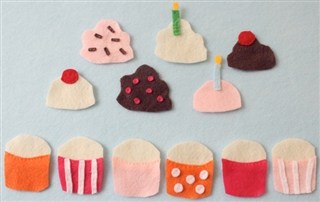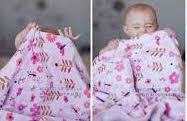How to Make Really Good Play Dough
 Spring colors and spring cookie cutters!
Spring colors and spring cookie cutters!
Ingredients
1 cup flour
1/2 cup salt
2 teaspoons cream of tartar (alum works well, too)
1 cup water
2 tablespoons vegetable oil
food coloring (use icing gels for more vibrant colors)
Instructions
- Heat water, oil, and food coloring in saucepan until boiling.
- Mix flour, salt, and cream of tartar and add to heated water mixture, mixing until dry ingredients are moistened. Do not let mixutre stick to the pot.
- Dump the mixture onto a cookie sheet or tray and let it cool slightly.
- Knead, knead, and knead! The secret to great play dough is in the kneading. Knead until soft and smooth. When it’s cool enough, children can help with this part.
Play dough will keep in a tightly lidded container for a few months.
Painting with Sensory Balls
Materials
Large box
Construction paper
2-4 sensory balls
Tempera paint
Cereal bowls or containers for paint
1 large spoon for each color of paint
Glitter (optional)
Directions
Toddler Art: It’s the Process, Not the Product
Art for young children is a learning experience when children are discovering what is stimulating, interesting, and engaging. They are most interested in experimenting and doing art rather than making a finished product. During the process, the children experience the joy of exploration, the delight of creating, and sometimes the frustration of challenges.
The art process can be sensory, such as feeling slippery cool paint on bare fingers. Other times it is a mysterious surprise as colors blend unexpectedly. The adult’s job is simply to allow this process to happen! Provide interesting materials, offer help with materials that may be challenging to use, but it is best not to make art samples to copy, as this tends to limit the possibilities of the process and may hinder the world of discovery and creativity.
- Tell me about your artwork (painting, drawing, playdough)
- I see you’ve used many colors!
- How does the paint feel?
- Tell me about the _____ part.
- Varieties of paper
- Glue, paste, tapes
- Paints, chalk
- Fabric, yarn
- Scissors
- Natural materials
- Recycled materials (cardboard tubes, plastic milk jugs, junk mail)
- Various writing instruments (crayons, markers, colored pencils)
“Donut” Printing
Materials
Pool noodle cut in 2-3 inch segments
Large paper
Tempera paint
Paper plate
Directions
Pour a small amount of tempera paint on a paper plate. Invite your child to gently press the end of the pool noodle segment into the paint and then press it onto the paper. The noodle makes fun donut-shaped prints. Dry completely and display.
Cupcake Flannel Board Play
Materials
Various colors of felt
Sharpie
Scissors
Directions
Using a Sharpie marker, draw bottoms of cupcakes (cupcake papers) on various colors of felt. Cut out bottoms. Draw cupcake tops using various felt colors. Cut out cupcake tops. Using scraps of felt, cut out various shapes for decorations (e.g. cherries, sprinkles, candles, hearts, etc.) Using a board covered with flannel or a carpeted area, invite your child to create various cupcakes. Your child will enjoy creating and recreating many kinds of cupcakes. Have fun!
Patterns with Cupcake Foam Stickers
Materials
Muffin pan
Cupcake Foam Stickers
Directions
Provide cupcake foam stickers. For younger children, you may want to limit the stickers to two different kinds. For older preschool age children, provide a variety of stickers to encourage more interesting and challening patterns. To introduce the idea of a pattern to your child, start with just two different stickers and place them in the muffin pan using an ABAB pattern. Invite your child to copy the same pattern in the row underneath. Once your child has mastered copying a pattern, ask him to extend your pattern by asking what comes next in the pattern. This will help you determine if you child understands that a pattern repeats. The last step is generating his own patterns and learning how to make more complex patterns using 3, 4, or more different objects.
Understanding the concept of patterns help children see patterns in numbers, literacy, music, and all around them!
Pig Pancakes
Ingredients
Pancake Mix
Raisins
Stawberries
Bananas
Directions
Make pancakes as directed. Cut a strawberry in half from top to bottom and place at the top of the cooked pancake. Add raisins for eyes and a banana button for the nose. Place two more raisins on the banana to complete the snout. Enjoy as a special breakfast or morning snack.
Puffy Paint Cookies
Ingredients
White glue
Plain shaving cream
Brown Tempera paint
Spoon
Bowl
Paper plate
Brown paper
Circle paper punch
Directions
Put 3/4 cup of shaving cream and 1/4 cup of white glue into a bowl and mix. Add in some brown paint and mix well. Glop it on the paper plate, taking your time to feel it in all it’s goopiness. While your child is playing/painting the plate cut out some “chocolate chips” from the paper. Add them to the cookie. Dry completely.
Infant Game: Baby Found
Materials
Handkerchief
How to Play
- Place the handkerchief over the baby’s head and pretend you cannot find him.
- Say, “Where’s (baby’s name)?”
When the baby takes off the handkerchief, get excited and say, “Oh, there’s (baby’s name)!” - Encourage the baby to put the handkerchief on his head all by himself.









